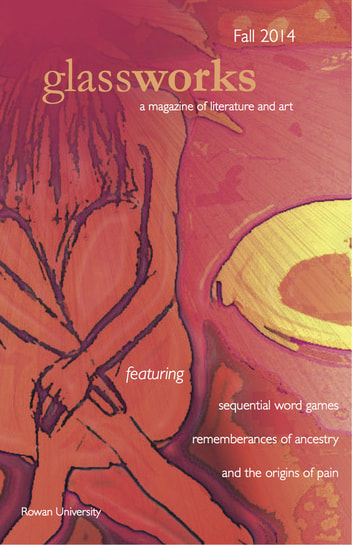|
lookingglass
Through the "Looking Glass," readers are invited to dig deeper into our issues as contributors share reflections on their work. Specifically, "Looking Glass" provides a sort of parlor where authors and artists reveal the genesis of their pieces, as well as provide meta-discursive insight into their textual and visual creative works. Issue 9 Reflections
Read on for reflections by select authors and artists
on the genesis and craft of their pieces in Glassworks and then read the full issue online! |
Chrystal Berche
"A Study in Gestures"
I look at artwork as a series of possibilities that have come together; the what ifs, if you will. When I started this project, the idea was simple: to not let the three minute gesture drawings I had been required to complete for one of my art courses go to waste. It seemed a shame to just let them sit in a file cabinet and be forgotten. At first I considered just doing collaboration pieces, but the longer I looked at them, the more I started getting this vibe of freedom and whimsy, and I started thinking about how I could possibly portray that. I have to admit, I was stumped for quite a while, then one evening, I was helping my son take photos of bubbles when it dawned on me that they would make great background images. Just the patterns they made, and the colors that reflected off of them made me think about the gestures I’d drawn, but when I started to put the pieces together I realized that the bubbles just wouldn’t be enough, so again, I put the images aside and the files sat in a folder that I’d open every now and again and stare at, wondering what element would help pull it all together. Then one night I was sitting at the computer writing by candlelight with some incense burning and I started watching the smoke, the way it drifted and flowed and it was that really clichéd moment when the light bulb flashed in in my head and the next thing I knew I was setting up black velvet as a background and lighting candles and taking pictures of incense and then layering them into the image with the bubbles and the dancers and that’s really the moment when everything came together. When I think back on that first dancer that I really felt proud of, I realize that was the moment when I just knew that I could make something special out of those images.
Ruth Foley
|
Ruth Foley
|
Martha Silano
|
Martha Silano
|
Kimberly McClintock
"The Garden State" and "In the Apple Tree"
I grew up with cosmopolitan aspirations in a rural, southern New Jersey town. Much of my family lives near that same town, and I visit regularly. One such visit occurred the weekend of my 40th birthday, which is in October. Out for a run in the foggy early morning, I was awestruck—I’m tempted to say “anew,” but honestly it may have been for the first time—by the gorgeousness of the landscape. It was an honest discovery, as I say in the poem: nothing I’d encountered elsewhere in the world seemed that morning any lovelier than the landscape of my childhood.
This coincided more or less with the birth of my sister’s first child—the first baby in our family in nearly forty years. I began writing about the collision of my memories with reality, particularly of interest to me is the landscape which, on the surface, I would argue is concrete and objective. That was my concern in the “Garden State”—when I could see the place freshly, its loveliness was shocking.
Ex-patriots of New Jersey are subject to jokes that turn on the irony of the state nickname, “The Garden State,” and so I took that as the title of this poem. I don’t mean it as the comedians do, ironically in the sense of north Jersey compared to south, but more personally—a reverse Eden, the snake evident in my memories, perhaps only ever existing there.
The situation depicted in my poem "In the Apple Tree" is grounded in fact. As a child, I loved to climb trees and foolishly got stuck in the upper branches, over and over, spending terrified hours there. My mother gave the same advice each time, which, though it seemed useless to me, turned out to be perfectly reasonable: you get down the same way you got up. Which is to say, the trick to getting down is not looking down—which you don’t, of course, on the way up or you probably wouldn’t climb so high the first place. In that, it's a bit like writing.
A nod to the darker facts alluded to in the piece—a local child did die of Rocky Mountain Spotted Fever, though I didn’t know him and my parents don’t remember the family name. They lived a few streets over from us in Victory Lakes.
“In the Apple Tree” was written at about the same time as “The Garden State,” along with a dozen or more others that also concern my family and the landscape, a series that will be included in my second book, Say Shadow.
This coincided more or less with the birth of my sister’s first child—the first baby in our family in nearly forty years. I began writing about the collision of my memories with reality, particularly of interest to me is the landscape which, on the surface, I would argue is concrete and objective. That was my concern in the “Garden State”—when I could see the place freshly, its loveliness was shocking.
Ex-patriots of New Jersey are subject to jokes that turn on the irony of the state nickname, “The Garden State,” and so I took that as the title of this poem. I don’t mean it as the comedians do, ironically in the sense of north Jersey compared to south, but more personally—a reverse Eden, the snake evident in my memories, perhaps only ever existing there.
The situation depicted in my poem "In the Apple Tree" is grounded in fact. As a child, I loved to climb trees and foolishly got stuck in the upper branches, over and over, spending terrified hours there. My mother gave the same advice each time, which, though it seemed useless to me, turned out to be perfectly reasonable: you get down the same way you got up. Which is to say, the trick to getting down is not looking down—which you don’t, of course, on the way up or you probably wouldn’t climb so high the first place. In that, it's a bit like writing.
A nod to the darker facts alluded to in the piece—a local child did die of Rocky Mountain Spotted Fever, though I didn’t know him and my parents don’t remember the family name. They lived a few streets over from us in Victory Lakes.
“In the Apple Tree” was written at about the same time as “The Garden State,” along with a dozen or more others that also concern my family and the landscape, a series that will be included in my second book, Say Shadow.
Timothy B. Dodd
|
Stan Lee Werlin
|


